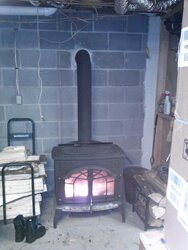Tracking on the loss through the concrete, North. We're in the process of a fairly extensive renovation, to include deep energy retrofit. Eventually, the block walls and floor will all be insulated. The renovation is part of the reason we went with this stove... no central air/ heat in here, long term plan is to have in floor heating run by an array of solar hot water panels for the bulk of our heating needs. Figured we'd use wood as backup and supplemental when the panels aren't producing the heat we need. Also, until we get to that point, this was going to be our main source of heat. I've awarded myself a Google doctorate in heat transfer, and while heat transfer from the basement to the first floor won't be ideal, I've incorporated a few design tweaks (completely open stairwell, floor vents, etc) that will optimize it as much as I can. (One of the misses' contingencies on my pursuit of complete self reliance is that I can't completely abandon aesthetics. We ran the Timberline as an insert on the main floor the first year we lived hear, and after humping wood up the stairs for four months, and the God awful mess in the main living space, we both decided that wasn't going to work. So, to the basement we go.) Regardless of basement or main floor, I'm still putting BTU's inside my living envelope, which is the end goal. Going apples for apples, the Timberline used to run us out of the house. On days where I really got it cooking, the basement would be over 100, main floor was 80+, second story was usually closed off, but still above 60. I've yet to get the IR to warm the basement over 80. And we've since replaced the old ratty R-19 in the ceiling with R-19 batt over top of an inch and a half of closed cell foam spray foam (bout R-7 per inch), I figure we're better off insulation wise than last year.
But, long story short, yeah, I know. Wife is never going to allow "ideal", so I'm going with "as close as possible without pissing her off."


